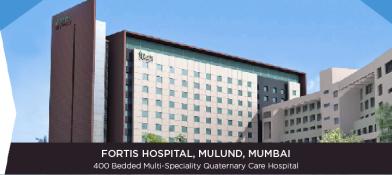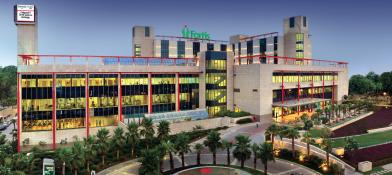Stem Cell Transplant
Overview
A stem cell transplant replaces abnormal stem cells in the body with healthy ones. This is done to treat cancers or autoimmune diseases. The stem cells can be extracted from a donor or prepared from the patient. This helps replace cancerous, damaged, or abnormal stem cells with healthy ones.
Stem cells: Stem cells are special kinds of regenerative cells in the body that can transform into any other type of cells. They constantly divide into other kinds of cells. This is called differentiation of stem cells. They are majorly present in the bone marrow and, to some extent, in other tissues. They can divide into any type of cells, like the white or red blood cells. They are needed for maintenance and repair of the tissues. After dividing and maturing in adult cells, they travel to different areas of the body where they are meant to perform their function. These come from various sources like embryonic, adult, and perinatal stem cells.
Indications
Stem cell therapy is indicated for various treatments like:
- Bone marrow failure causes a deficiency of all types of cells called Aplastic Anemia
- Cancers like leukemia, Hodgkin’s, and Non-Hodgkin’s lymphomas
- The inability of the bone marrow to make blood cells is called bone marrow failure syndrome.
- Deficiency of immunity causing various diseases
- Blood cancer is called multiple myeloma.
- Brain cancer is called neuroblastoma.
Criteria for Stem Cell Transplant
Individuals who benefit from stem cell therapy include young individuals who did not have many treatments in the past and are in the early stages of the disease.
Contraindications
Stem cell therapy is not indicated in the following:
- It is not advisable to have donor stem cells transplanted in individuals more than 50 years old.
- It is not advisable to have stem cells transplanted from self in individuals more than 60 years old.
- Stem cell therapy is not indicated in the late stages of the disease.
- It is also not indicated for individuals with life-threatening conditions.
Types of Stem Cell Therapy
Based on the individual source from which the stem cells are taken, they are of two types. They are:
- If stem cells are taken from the patient's blood and are given after cancer treatment are called autologous stem cell transplants
- If the stem cells are taken from other individuals, harvested, and given to the recipient through an intravenous route, they are called allogenic stem cell transplants.
Based on the body part source from which these are taken, it is of different types. They include stem cells taken from the
- Bone marrow
- Peripheral blood
- Cord blood.
Before the Procedure
Before the stem cell transplant, the individual should understand the importance, necessity, and type of transplant being done by discussing it with the healthcare professional. Certain parameters are evaluated by blood tests, physical examinations, imaging studies, psychological evaluation, and other necessary tests to assess the overall health condition. The entire history regarding previous illnesses, surgeries, medicines taken, and allergies should be shared with the concerned healthcare professional. Based on the test results and evaluation, one will be informed if they can be taken for a stem cell transplant.
Matching a donor for transplantation is also very important for a stem cell transplant. Donors will also be evaluated and subjected to tests to check for compatibility. These tests include blood typing (to check if the match between blood groups of donor and recipient), tissue typing (to check if the transplanted tissue will last for a long time in the recipient's body), crossmatch (to check if antibodies of the recipient will reject the donor tissue). Based on the types of donors, there are of two types. They are:
- Family donors – Family members with identical genes are identified and checked for transplantation. Generally, siblings can be considered for this procedure as they can have identical and matched genes. Any close family member can also be taken as a donor if they match.
- Unrelated donors – This includes individuals who are not family or related to the individual. They can be considered if there are any matched and identical genes.
An individual has to be active and healthy for a successful stem cell transplant. Taking the prescribed medications on time, having a proper diet, regular exercise, and relaxing can keep one healthy and fasten the recovery after transplant.
During the Procedure
During the transplant, the stem cells are transplanted through an intravenous line. Before transplantation, the stem cells undergo two procedures. They are:
- Conditioning – Cancer cells are killed by using radiation or chemotherapy. This creates space in the bone marrow for the transplanted stem cells. This also suppresses the immune system to reduce the rejection and decrease further complications.
- Harvesting – New stem cells are collected from the donor or the individual. This can be collected from blood bone marrow or an umbilical cord. If blood is collected from a donor, the collected blood is sent to a machine that separates the white blood cells and sends back the remaining into the donor’s body. These collected cells can be conditioned till transplanted.
The harvested and conditioned stem cells are transferred to the recipient through an intravenous line. These transplanted cells should reach the recipient’s bone marrow to divide further and produce new cells.
After the Procedure
Medications are given to suppress the immune system to reduce the chances of rejection.
Side Effects
Nausea, vomiting, fever-like symptoms, diarrhea, and altered taste are some of the side effects of the procedure.
Risks and Complications
Rejection of the stem cells, a disease called graft versus host disease where the donor’s cells start attacking the recipient’s cells leading to life-threatening situations, and multiple-organ damage are some of the risks and complications.
Conclusion
Stem cell therapy is an advanced medical therapy to treat cancers. Donor cells from the same individual or other compatible individuals are selected for stem cell therapy. Stem cell therapy can increase survival rates and offer new hope for individuals receiving them.




















